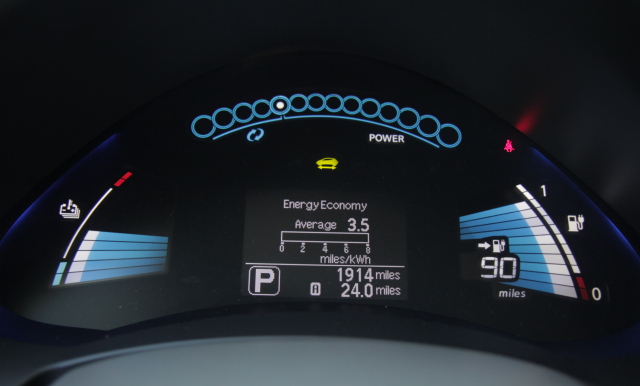
I was way too literal in my thinking about the Leaf. I thought, “100 miles of range, great. I can go to work and back almost three times before I have to recharge." It’s about 33 miles from the Oakland Hills into where I work in San Francisco and back. I didn’t understand that I simply would never get 100 miles of range despite driving much more efficiently. I also didn’t realize, at the time, that it’s best to charge to 80% to extend battery life. So, now I pretty much have to charge between every trip.
I realized a lead foot and maybe climate control would reduce my range but I didn’t consider all of the other possible factors that would cut into my range including: terrain, weather, speed, elevation, technique and even how long ago I last charged. After four months of driving I am getting some ideas of what to do to eke out more miles. Also, I have been getting tips from several sites including: Mynissanleaf.com. While some of this might be specific to the Leaf, some tips are general ones that can apply to any of the upcoming electric car releases such as Mitsubishi’s i electric and the 2012 Ford Electric Focus. Oh, and if you have ideas on how to extend range, by all means, share!
1. Count bars, not miles
Don’t look at the DTZ (Distance to Zero) which counts backwards from your mileage starting point. Leaf drivers call it the "guess o’meter". Look at the bars. This will help you not freak out. Battery-powered cars have huge mileage swings with climate control, acceleration, speed and elevation gains being the biggest. For those not driving a Leaf, the car has twelve bars stacked on top of each other. You can see this to the right of the dashboard on the photo above. Daily, I work with ten bars since I charge to 80%. If I average my road and highway driving during a moderate winter in the San Francisco Bay Area, I am getting almost 7 miles per bar.
2. Bundle up
If you really need to eke out every mile, don’t use the climate control. In extreme weather, the heat can cut the energy by 30%. It is a drag. It is best to use your seat warmers if you have them (I don't). Also, try heating up your car while it is still teathered to your charger (you can program it to go on before you go to work or use a phone app to turn it on from the warmth of your home.)
3. Follow the bubbles
While it is not the best efficiency gauge, I follow the power meter on the dashboard of the Leaf. You can see it in the picture above. The meter displays the motor power and the regenerative brake power. The white dot, or bubble, in the display moves to the right when you are accelerating and to the left when power is generated by breaking. I generally try to keep the bubbles from increasing too much to the right.
4. Drive in Eco
This probably goes without saying but most hybrd plug-ins and electric cars have different drive options. The Leaf has two drive choices, drive and eco. Drive gives you that fast zoom and eco helps the car capture more energy.
